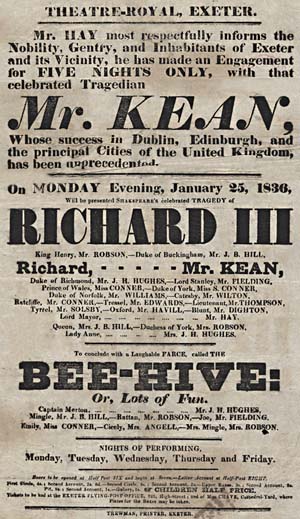Theatre Royal, Exeter on:
[Wikipedia]
[Google]
[Amazon]
 The Theatre Royal, Exeter was the name of several
The Theatre Royal, Exeter was the name of several
 The theatre is best remembered for the disaster during a dramatisation of ''Romany Rye'' (a melodrama by
The theatre is best remembered for the disaster during a dramatisation of ''Romany Rye'' (a melodrama by
 The Theatre Royal, Exeter was the name of several
The Theatre Royal, Exeter was the name of several theatres
Theatre or theater is a collaborative form of performing art that uses live performers, usually actors or actresses, to present the experience of a real or imagined event before a live audience in a specific place, often a stage. The perform ...
situated in the city centre of Exeter, Devon, England in the United Kingdom.
Early theatres and fires
The name "Theatre Royal" was first applied in Exeter by the mid-1830s to what had previously been the Bedford Circus Theatre, in premises dating from 1821. This theatre building was a replacement for one of 1787 which had burnt down the previous year. This building was completely gutted by fire in 1885. Although it was reconstructed for other purposes, the name "Theatre Royal" was transferred to new premises on the corner of Longbrook Street and New North Road. The new theatre was built by the Exeter Theatre Company to the designs of C. J. Phipps and opened in 1886.Fire disaster
 The theatre is best remembered for the disaster during a dramatisation of ''Romany Rye'' (a melodrama by
The theatre is best remembered for the disaster during a dramatisation of ''Romany Rye'' (a melodrama by Wilson Barrett
Wilson Barrett (born William Henry Barrett; 18 February 1846 – 22 July 1904) was an English manager, actor, and playwright. With his company, Barrett is credited with attracting the largest crowds of English theatregoers ever because of his suc ...
) on 5 September 1887, which became the worst theatre fire in British history. Fire broke out backstage where gas lighting
Gas lighting is the production of artificial light from combustion of a gaseous fuel, such as hydrogen, methane, carbon monoxide, propane, butane, acetylene, ethylene, coal gas (town gas) or natural gas. The light is produced either directly ...
ignited some gauze. The number of exits from the gallery of the auditorium proved to be inadequate and in the resultant panic amongst the audience 186 people died. A national appeal for donations for the victims’ families raised £20,763 and the event was influential in the introduction of safety precautions for public buildings. There is a memorial to those who died in the fire in Higher Cemetery, Heavitree
Heavitree is a historic village and parish situated formerly outside the walls of the City of Exeter in Devon, England, and is today an eastern district of that city. It was formerly the first significant village outside the city on the road to ...
, made by local sculptor Harry Hems
Harry Hems (12 June 1842 – 5 January 1916) was an English architectural and ecclesiastical sculptor who was particularly inspired by Gothic architecture and a practitioner of Gothic Revival. He founded and ran a large workshop in Exeter, Devon ...
.
The last theatre
The Theatre Royal was rebuilt, opening in 1889 with a performance of ''The Yeomen of the Guard
''The Yeomen of the Guard; or, The Merryman and His Maid'', is a Savoy Opera, with music by Arthur Sullivan and libretto by W. S. Gilbert. It premiered at the Savoy Theatre on 3 October 1888 and ran for 423 performances. This was the eleventh ...
'' by the D'Oyly Carte Opera Company
The D'Oyly Carte Opera Company is a professional British light opera company that, from the 1870s until 1982, staged Gilbert and Sullivan's Savoy operas nearly year-round in the UK and sometimes toured in Europe, North America and elsewhere. The ...
. The new building had lighting by electricity and a safety curtain
A safety curtain (or fire curtain in America) is a fire safety precaution used in large proscenium theatres. It is usually a heavy fibreglass or iron curtain located immediately behind the proscenium arch. Asbestos-based materials were ori ...
.
During its lifetime the theatre presented melodrama, musical theatre, music hall and ballet as well as drama. Every Christmas of its 20th century existence saw a pantomime. For a period in the 1950s it showed CinemaScope films.
The Theatre Royal was closed in 1962 and demolished
Demolition (also known as razing, cartage, and wrecking) is the science and engineering in safely and efficiently tearing down of buildings and other artificial structures. Demolition contrasts with deconstruction, which involves taking a ...
to be replaced by an office block. Although attempts to save it were unsuccessful, they did lead to creation of the Northcott Theatre
The Northcott Theatre is a theatre situated on the Streatham Campus of the University of Exeter, Exeter, Devon, England. It opened in 1967 and was run until 2010 by the Northcott Theatre Foundation, when the company ceased operating after a p ...
.
References
Further reading
* * * {{cite book, author=Passmore, Dick, title=The Story of the Theatre Royal Exeter, publisher=The Mint Press, year=2002, isbn=1-903356-21-0 Theatres in Devon Fires in England Charles J. Phipps buildings Buildings and structures in Exeter